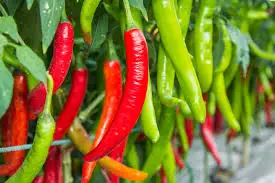Last Updated on April 11, 2024 by Real Men Sow
Overwintering your chilli peppers during winter will give you more peppers in the spring if you don’t want the hassle of seed-starting them in the spring. You can keep pepper plants healthy through the winter frost by doing some pepper winter care indoors. You will need to remove your pepper plants from the garden and plant them in a container before bringing them inside.
Overwintering pepper plants will only keep them alive but will not produce fruit. Peppers require higher temperatures and more light than average US homes to produce fruit. Although it is not difficult to overwinter peppers, here are some tips to help you make it easier.
If you live in a warm climate, where there is no frost and it doesn’t get too cold outside, your plants will be fine outdoors. My container-grown plants are outside all winter here in Southern California. They are ready to go once Spring arrives.
Bring Your Chilli Peppers During Winter Indoors
First, bring your pepper plants indoors before the frost. Be sure to spray the entire plant including the roots before you start. This will eliminate any pests hiding on the roots or leaves. All pepper fruits, immature or mature, should be removed from the plant.
Dig up as many roots as possible when transplanting pepper plants from the garden into a container. This will allow your plants to absorb nutrients and moisture from the soil in spring when they are replanted back into the garden.
When transplanting, DO NOT USE POTTING SOIL. It is tempting to plant your peppers in your garden soil, but it’s not a good idea. The soil in your garden is full of pests and will spread throughout your home once it warms up. Use fresh potting soil instead when transferring your plants to pots.
Put Them in a Proper Location
Once you bring your peppers inside, there are two places where you can place them. The first is a dark, cool basement that gets very little light. This will cause the plants to go into dormancy. Although they may appear dead, they are actually alive. You’ll need to ensure that the soil does not become too dry or wet during this time of dormancy.
You can also place your pepper plants in a sunny window or under grow light. They may not go dormant in this situation, but they will most likely not bear fruit until the spring. They will need a little more water than fully dormant plants in a dark basement.
Cut Back on Watering
After you’ve placed your pepper plant, reduce the amount of watering. Peppers will need less water in winter than they do in summer. The plant should be watered once every three to four weeks. You should not allow the soil to dry completely.
The pepper will begin to fall shortly after it is placed in a cool place and you have reduced the watering. This is normal. The pepper plant is in dormancy.
Prune Your Chilli Peppers During Winter
When the pepper plants’ leaves are starting to fall, you can trim them. This means that you can trim the plant to remove dead or injured branches. The branches should be cut to the main Y’s of the pepper plant, with a minimum of 1 to 2 inches. The upper portion of the Y. This will eliminate the dead leaves and make it less vulnerable to pests. In the spring, new branches will be developed by the pepper plant.
Prepare For Spring
About a month before the last frost date, take your pepper plant from its cool place and move it to a warmer, brighter location. To add heat, you may want to place a heating pad underneath the pot. You can resume watering the pepper plant, but don’t overwater it. Within a week, you will see new growth.

